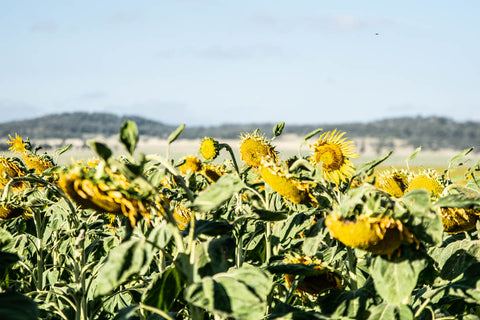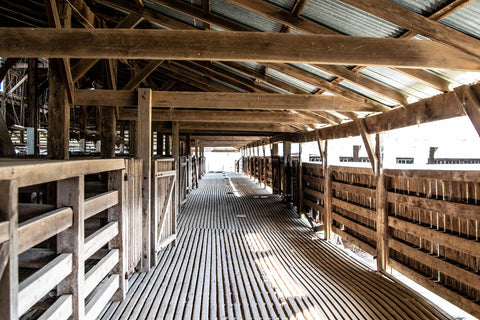Liverpool Plains Sunflower Trail




















It’s 6.45am when I arrive at the gate of “Windy Station” near Pine Ridge on the Liverpool Plains in north west New South Wales, and Clare Lee is flipping over the signage to ‘Open’ on the first event of the first ever Liverpool Plains Sunflower Trail 2022.
Clare is president of The Plains agritourism group, a collaboration of seven farmers and business owners excited about bringing attention to the food and fibre grown in their region.
For the next month there is a program of eleven events including open days, a paddock long table dinner, yoga, boutique market, creative courses, a concert, and pick-your-own sunflowers in mature crops at five locations across an area of about 100 square kilometres from Willow Tree and Wallabadah in the east to Premer in the west.
I am the first customer and there are still logistics to organise. With potentially thousands of visitors expected in the next week, this is a military style operation with to-do lists, traffic cones and temporary fencing protecting pedestrians, and most importantly country hospitality demonstrated by printed sunflowers on star pickets leading us to the 140-hectare paddock of “sunnies”.
Clare offers me access to the iconic NSW heritage-listed Windy Woolshed, but I am keen to take advantage of the early morning light on the sunflowers. She introduces me to Windy Station staffer Bec Andrews, appropriately dressed in a cheerful sunflower printed shirt, who leads the way to the sunflower paddock.
Bec gives simple instructions as I head off with my camera, “Be careful of bees, snakes, and don’t get lost.”
The visual scale of the commercial sunflower crop doesn’t disappoint. In an earlier conversation with The Plains committee member Eleanor Pengilley, she described what local farmers have to offer as “epic agriculture”.
To give you an idea of the scale Windy Station is part of Romani Pastoral Company including properties at nearby Warrah and Premer covering 20,234 hectares, grazing 6,000 Black Baldy Hereford Angus cross cattle and a crop rotation of sorghum, cotton, canola, wheat, feed barley, mung beans, chickpeas and of course sunflowers.
Distinctively The Plains group is a move towards borderless tourism crossing traditional local government area boundaries, in this case the Upper Hunter, Liverpool Plains, Gunnedah, and Tamworth LGAs.
Coinciding with a peak holiday period for visiting family and friends this month there will be a lot of eyes within reach of the Liverpool Plains Sunflower Trail. Liverpool Plains Shire Council Visitor Information Centre distributes a Sunflower Alert email.
The Plains has attracted funding from the National Recovery and Resilience Agency, recognising the need to give rural communities a leg up after years of drought, and more recently the COVID pandemic.
Walking among the sunflowers it is a sensual overload listening to the rustle of sunflower leaves shimmying in the wind. There are sunflowers for kilometres and my eye alternates from being drawn to the macro scale of row after row of golden sunflowers contrasting with twisted, gnarly gum trees bordering the paddock, and a flock of galahs and cockatoos feeding on sunflower seeds, taking flight as I approach, to the micro appeal of a bee collecting pollen, and the textural variation of delicate, thin, yellow petals, black and gold swaying seed heads, and elephant ear green foliage on wrist thick stems reaching above my head.
Preparing for my visit I Googled ‘How to photograph sunflowers’ and I was surprised by the search result volume. Photographing sunflowers is A Thing. Tips range from aperture and depth of field, to what to wear to contrast with the striking sunflowers, and how to pose. Who knew?
Local Quirindi-based photographer Sally Alden Photography posted practical tips on socials like checking flowering dates and opening hours, booking accommodation, filling car fuel tanks, and packing sunscreen, hats, snacks, water, maps and charged phone and camera batteries.
Bec and her team have created a path through the sunflowers and a spectacular vista opens up from the flat plain of sunflower heads to the ridge beyond. There is a platform made from enormous hay bales, for visitors to stand on for an elevated view across the top of the sunflowers.
A family arrives and is taking phone photographs of the sunflowers. Rachell and husband Erwin Magpantay have travelled with children Imogen and Oliver from the Liverpool area of Sydney specifically to see the sunflowers. Oliver has just woken up after being in the car and is snuggling into Dad’s neck.
“She just loves flowers,” Erwin says of wife Rachell.
“I’ve never seen them this big and up close,” Rachell says, looking up in awe at the towering flower heads.
By the end of day one about 100 people have visited.
As I drag myself away from the beguiling sunnies I joke with Bec, “How many photographs of sunflowers can I take?,” and she laughs recalling how she’s had to buy an additional memory card for her camera. “It’s therapeautic isn’t it?” She encourages me to come back to photograph the sunflowers at sunset later this week.
Before I leave Windy Station, I rejoin Clare on duty welcoming visitors at Windy Woolshed. Clare and husband David have managed Windy Station for four years. When they were being interviewed for the job, Clare could see the potential of the woolshed.
“I asked, ‘What happens with that shed?’ I love tourism, I love local and provenance.”
With the backing of the owners she’s been finding something to do with it.
As far as shearing sheds go, they don’t come much bigger than 44-stand Windy Woolshed. By comparison Clare says there are shearing sheds with more stands, but “In terms of its design it’s very unique and just the beauty of how it has stood up for 120 years. Very little has been done to the shed.”
The woolshed was designed by Fred B Menkens and built in 1901 by Thomas and William Cowan using timber cut from trees on the property. The Windy Station team is about to start a major conservation project on the woolshed working with a heritage architect and engineers to meet heritage requirements.
“All our plans went in three months ago. We have to do some minor tweaking on our ideas and then we can move forward on tenders and construction.”
At its peak the shed held more than 4,000 sheep and there would have been more than 100 people involved in shearing. There hasn’t been a commercial size sheep flock on Windy Station for 20 years, the property following a nation-wide shift from sheep and wool, to beef cattle and cropping.
“We still have 20 sheep to work our dogs with.”
Standing beside the wall of shearing stands stencilled with numbers, and surrounded by timber sheep pens polished by more than a century of lanolin, and original wicker baskets leaning from the weight of storing and sorting fleeces, it’s easy to imagine the bustle of activity in this building.
The high roof was a source of light and ventilation for the shearers, while two distinctive round windows in the pitch of the façade were designed to let owls in to control rodents.
Footage from the National Archives of Windy Woolshed in the 1940s brings the workplace alive, narrated by a long-gone BBC-esque English Australian accent. Clare has a soft spot for footage showing the wool classer walking around in his tie and hat.
She conjures a bustle of a different kind, describing restoration of large glass windows and timber shutters, plans for a commercial kitchen and introducing modern comforts like climate control and seating for up to 300 people for weddings and conferences. They’ve already hosted magazine and fashion shoots and training programs.
Windy Station has been part of a pilot program between the Office of Small Business, Liverpool Plains Shire Council and consultancy Regionality to put the call out to farmers and develop an agritourism plan. The Plains group evolved from that and the Liverpool Plains Sunflower Trail is its first event.
“We’re all building our own businesses; it’s a brand new committee and vision,” Clare says.
“We’re already planning events for sorghum, cotton and canola so people can come out and drive past or thorough paddocks and learn about their food and fibre.”
It’s a bright outlook and Clare gets a buzz out of the prospect of people visiting the region.
“That excites me personally, people can bring their creativity to the region, and our region can benefit.”
Connect with @theplains_au and @theplainsau and on Instagram and Facebook for event details at Windy Station, Little Willow Lavendar Farm, Wilgabah, Sandstone, and The Plantation.

















Megan Trousdale
Author